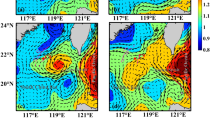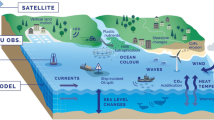Abstract
Estuarine ecosystem diversity and function can be degraded by low oxygen concentrations. Understanding the spatial and temporal patterns of dissolved oxygen (DO) variation and the factors that predict decreases in DO is thus essential to inform estuarine management. We investigated DO variability and its drivers in Elkhorn Slough, a shallow, well-mixed estuary affected by high nutrient loading and with serious eutrophication problems. Long-term (2001–2012), high-resolution (15 min) time series of DO, water level, winds, and solar radiation from two fully tidal sites in the estuary showed that hypoxia events close to the bottom are common in the summer at the more upstream estuarine station. These events can occur in any lunar phase (spring to neap), at any time of the day, and both on sunny or cloudy days. They are, however, short-lived (lasting in average 40 min) and mainly driven by momentary low turbulent diffusion around slack tides (both at high and low water). Tidal advective transport explains up to 52.1% of the daily DO variability, and the water volume (or DO reservoir) contained in the estuary was not sufficient to avoid hypoxia in the estuary. Solar radiation was responsible for a positively correlated DO daily cycle but caused a decreased in the averaged DO in the summer at the inner station. Wind-driven upwelling reduced the average DO at the more oceanic station during spring. The approach we employed, using robust techniques to remove suspect data due to sensor drift combined with an array of statistical techniques, including spectral, harmonic, and coherence spectrum analysis, can serve as a model for analyses of long-term water quality datasets in other systems. Investigations such as ours can inform coastal management by identifying key drivers of hypoxia in estuaries.












Similar content being viewed by others
References
Archer, C.L., M.Z. Jacobson, and F.L. Ludwig. 2004. The Santa Cruz eddy. Part I: observations and statistics. Monthly Weather Review 133: 767–782.
Beck, N.G., and K.W. Bruland. 2000. Diel biogeochemical cycling in a hyperventilating shallow estuarine environment. Estuaries 23: 177–187.
Beck, N.G., A.T. Fisher, and K.W. Bruland. 2001. Modeling water, heat, and oxygen budgets in a tidally dominated estuarine pond. Marine Ecology Progress Series 217: 43–58.
Beck, M.W., Hagy, J.D. III, and Murrell, M.C. 2015. Improving estimates of ecosystem metabolism by reducing effects of tidal advection on dissolved oxygen time series. Limnology and Oceanography: Methods. (in press).
Bricker, S.B., Clement, C.G., Pirhalla, D.E., Orlando, S.P. and Farrow, D.R.G.. 1999. Effects of nutrient enrichment in the nation’s estuaries. National Estuarine Eutrophication Assessment. NOAA-NOS Special Projects Office. 84 p.
Bricker, S.B., J.G. Ferreira, and T. Simas. 2003. An integrated methodology for assessment of estuarine trophic status. Ecological Modeling 169: 39–60.
Caffrey, J.M., M. Brown, W.B. Tyler, and M. Silberstein. 2002. Changes in a California estuary: a profile of Elkhorn Slough. Moss Landing: Elkhorn Slough Foundation.
Caffrey, J.M. 2004. Factors controlling net ecosystem metabolism in U.S. estuaries. Estuaries 27: 90–101.
Caffrey, J.M., T.P. Chapin, H.W. Jannasch, and J.C. Haskins. 2007. High nutrient pulses, tidal mixing and biological response in a small California estuary: variability in nutrient concentrations from decadal to hourly time scales. Estuarine, Coastal and Shelf Science 71: 368–380.
Caffrey, J.M., J.T. Hollibaugh, N. Bano, and J.C. Haskins. 2010. Effects of upwelling on short-term variability in microbial and biogeochemical processes in estuarine sediments from Elkhorn Slough, California, USA. Aquatic Microbial Ecology 58: 261–271.
CENR (Committee on Environment and Natural Resources). 2000. Integrated assessment of hypoxia in the Northern Gulf of Mexico. National Science and Technology Council, 58 p.
Chapin, T.C., J.M. Caffrey, H.W. Jannasch, L.J. Coletti, J.C. Haskins, and K.S. Johnson. 2004. Nitrate sources and sinks in Elkhorn Slough, California: results from long-term continuous in situ nitrate analyzers. Estuaries 27 (5): 882–894.
Collins, J.R., P.A. Raymond, W.F. Bohlen, and M.M. Howard-Strobel. 2013. Estimates of new and total productivity in central Long Island Sound from in situ measurements of nitrate and dissolved oxygen. Estuaries and Coasts 36: 74–97. https://doi.org/10.1007/s12237-012-9560-5.
Emery, W.J., and R.E. Thompson. 2004. Data analysis methods in physical oceanography. Oxford: Pergamon Press.
Gardner, J.R., and C. Gorman. 1984. The summertime net transport of dissolved oxygen, salt and heat in a salt marsh basin, North Inlet, S.C. Estuarine, Coastal and Shelf Science 19 (3): 331–339.
Gray, J.S., R.S. Wu, and Y.Y. Or. 2002. Effects of hypoxia and organic enrichment on the coastal environment. Environmental Science and Pollution Management 238: 249–279.
Harris, L.A., C.M. Duarte, and S.W. Nixon. 2006. Allometric laws and prediction in estuarine and coastal ecology. Estuaries and Coasts 29: 340–344.
Hughes, B.B., J.C. Haskins, K. Wasson, and E. Watson. 2011. Identifying factors that influence expression of eutrophication in a central California estuary. Marine Ecology Progress Series 439: 31–43.
Hughes, B.B., R. Eby, E. Van Dyke, M.T. Tinker, C.I. Marks, K.S. Johnson, and K. Wasson. 2013. Recovery of a top predator mediates negative eutrophic effects on seagrass. Proceedings of the National Academy of Sciences 110 (38): 15313–15318.
Hughes, B.B., M.D. Levey, M.C. Fountain, A.B. Carlisle, F.P. Chavez, and M.G. Gleason. 2015. Climate mediates hypoxic stress on fish diversity and nursery function at the land–sea interface. Proceedings of the National Academy of Sciences 112 (26): 8025–8030.
Jannasch, H.W., L.J. Coletti, K.S. Johnson, S.E. Fitzwater, J.A. Needoba, and J.N. Plant. 2008. The Land/Ocean Biogeochemical Observatory: a robust networked mooring system for continuously monitoring complex biogeochemical cycles in estuaries. Limnology and Oceanography: Methods 6: 263–276.
Lalli, C.M., and T.R. Parsons. 1993. Biological oceanography: an introduction. Second ed. Vancouver: University of British Columbia.
Largier, J.L., J.T. Hollibaugh, and S.V. Smith. 1997. Seasonally hypersaline estuaries in Mediterranean-climate regions. Estuarine, Coastal and Shelf Science 45: 789–797.
Lin, J., H. Xu, C. Cudaback, and D. Wang. 2008. Inter-annual variability of hypoxic conditions in a shallow estuary. Journal of Marine Systems 73: 169–184.
Kim, T., and T. Khangaonkar. 2012. An offline unstructured biogeochemical model (UBM) for complex estuarine and coastal environments. Environmental Modeling & Software 31: 47–63.
Los Huertos, M. and Sanso, B. 2008. Seasonal and long-term trends in dissolved oxygen, pH, and salinity in Elkhorn Slough, California. Statistical analysis of sixteen years of water quality data project—final report. 92 to the Elkhorn Slough Foundation and the Community Foundation for Monterey County. University of California Santa Cruz, p. 44–58.
Moatar, F., J. Miquel, and A. Porrel. 2001. A quality-control method for physical and chemical monitoring data. Application to dissolved oxygen levels in the river Loire (France). Journal of Hydrology 252 (1–4): 25–36.
NCDC (National Climatic Data Center). 1990. Climatic summaries for NDBC data buoys and stations, published by National Data Buoy Center, prepared by Naval Oceanography Command Detachment, Asheville, NC, Published by Commander, Naval Oceanography Command. Update 1.
Nelson, C.S. 1977. Wind stress and wind stress curl over the California Current. In NOAA Technical Report, 87 pp. U.S.: Department of Commerce, NOAA/NMFS.
Nezlin, N.P., K. Kamer, J. Hyde, and E.D. Stein. 2009. Dissolved oxygen dynamics in a eutrophic estuary, Upper Newport Bay, California. Estuarine, Coastal and Shelf Science 82: 139–151.
Nidzieko, N.J. 2009. Dynamics of a seasonally low-inflow estuary: circulation and dispersion in Elkhorn Slough, California. PhD Dissertation, Department of Civil and Environmental Engineering, Stanford University, 242 P.
Nidzieko, N.J., and S.G. Monosmith. 2013. Contrasting seasonal and fortnightly variations in the circulation of a seasonally inverse estuary, Elkhorn Slough, California. Estuaries and Coasts 36: 1–17.
Nidzieko, N.J., J.A. Needoba, S.G. Monosmith, and K. Johnson. 2014. Fortnightly tidal modulations affect net community production in a mesotidal estuary. Estuaries and Coasts 37 (Suppl 1): S91–S110.
O’Donnell, J., H.G. Dam, W.F. Bohlen, W. Fitzgerald, P.S. Gay, A.E. Houk, D.C. Cohen, and M.M. Howard-Strobel. 2008. Intermittent ventilation in the hypoxic zone of western Long Island Sound during the summer of 2004. Journal of Geophysical Research 113: C09025.
Pawlowicz, R., B. Beardsley, and S. Lentz. 2002. Classical tidal harmonic analysis including error estimates in MATLAB using T_TIDE. Computer & Geosciences 28: 929–937.
Portnoy, J.W. 1991. Summer oxygen depletion in a diked New England estuary. Estuaries 14 (2): 122–129.
Rabalais, N.N. and Turner, R.E. 2001. Coastal hypoxia: consequences for living resources and ecosystems. In coastal and estuarine studies, 1–36. Washington, DC AGU.
Rabalais, N.N. and Gilbert, D. 2009. Distribution and consequences of hypoxia. In watersheds, bays and bounded seas, 209–226. Washington, DC: Island Press.
Renaud, M.L. 1986. Hypoxia in Louisiana coastal waters during 1983: implications for fisheries. Fishery Bulletin 84: 19–26.
Reynolds-Fleming, J.V., and R.A. Luettich Jr. 2004. Wind-driven lateral variability in a partially mixed estuary. Estuarine, Coastal and Shelf Science 60: 395–407.
Roegner, G., J. Needoba, and A. Baptista. 2011. Coastal Upwelling Supplies Oxygen-Depleted Water to the Columbia River Estuary. PloS one. 6. e18672. https://doi.org/10.1371/journal.pone.0018672.g001
Sanford, L.P., K.G. Sellner, and D.L. Breitburg. 1990. Covariability of dissolved oxygen with physical processes in the summertime Chesapeake Bay. Journal of Marine Research 48: 567–590.
Shen, J., T. Wang, J. Herman, P. Mason, and G.L. Arnold. 2008. Hypoxia in a coastal embayment of the Chesapeake Bay: a model diagnostic study of oxygen dynamics. Estuaries and Coasts 31: 652–663.
Shields, E.A., and A. Weidman. 2008. A quantitative approach to characterizing hypoxic events. Journal of Coastal Research, Special Issue 55: 50–58.
Van Dyke, E., and K. Wasson. 2005. Historical ecology habitat change of a central California estuary: 150 years of habitat change. Estuaries 28 (2): 173–189.
Vaquer-Sunyer, R., and C.M. Duarte. 2008. Thresholds of hypoxia for marine biodiversity. PNAS 105: 15452–15457.
Vinnedge Environmental Consulting. 2010. Final initial study and mitigated negative declaration parsons slough project. State Clearinghouse Number 2010041084.
Acknowledgements
We are grateful to Ron Eby, Rikke Jeppesen, and Miguel Rodriguez for assistance in the field and to Mike Kennish for improving the manuscript. Nick Nidzieko generously provided extensive suggestions that strengthened the analyses and writing.
Funding Information
This work was supported by a grant from the Fundação de Amparo à Pesquisa do Estado da Bahia (supporting RS) and grants from NOAA’s Office for Coastal Management to the Elkhorn Slough Foundation on behalf of the Elkhorn Slough Estuarine Research Reserve (supporting GL, JH, and KW).
Author information
Authors and Affiliations
Corresponding author
Additional information
Communicated by Charles Simenstad
Rights and permissions
About this article
Cite this article
Santana, R., Lessa, G.C., Haskins, J. et al. Continuous Monitoring Reveals Drivers of Dissolved Oxygen Variability in a Small California Estuary. Estuaries and Coasts 41, 99–113 (2018). https://doi.org/10.1007/s12237-017-0329-8
Received:
Revised:
Accepted:
Published:
Issue Date:
DOI: https://doi.org/10.1007/s12237-017-0329-8




